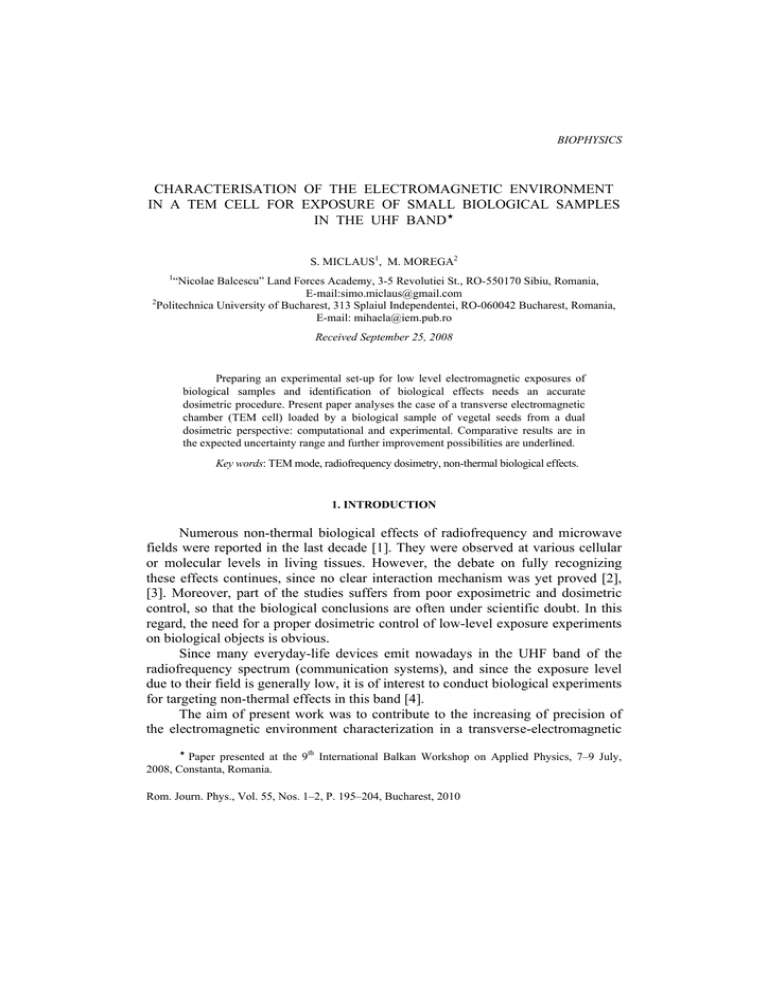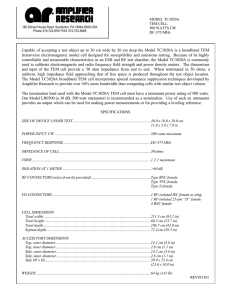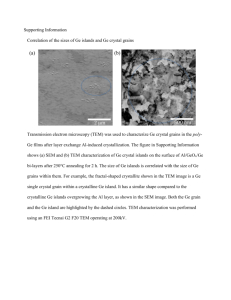characterisation of the electromagnetic environment in a tem cell for
advertisement

BIOPHYSICS CHARACTERISATION OF THE ELECTROMAGNETIC ENVIRONMENT IN A TEM CELL FOR EXPOSURE OF SMALL BIOLOGICAL SAMPLES IN THE UHF BAND S. MICLAUS1, M. MOREGA2 1 “Nicolae Balcescu” Land Forces Academy, 3-5 Revolutiei St., RO-550170 Sibiu, Romania, E-mail:simo.miclaus@gmail.com 2 Politechnica University of Bucharest, 313 Splaiul Independentei, RO-060042 Bucharest, Romania, E-mail: mihaela@iem.pub.ro Received September 25, 2008 Preparing an experimental set-up for low level electromagnetic exposures of biological samples and identification of biological effects needs an accurate dosimetric procedure. Present paper analyses the case of a transverse electromagnetic chamber (TEM cell) loaded by a biological sample of vegetal seeds from a dual dosimetric perspective: computational and experimental. Comparative results are in the expected uncertainty range and further improvement possibilities are underlined. Key words: TEM mode, radiofrequency dosimetry, non-thermal biological effects. 1. INTRODUCTION Numerous non-thermal biological effects of radiofrequency and microwave fields were reported in the last decade [1]. They were observed at various cellular or molecular levels in living tissues. However, the debate on fully recognizing these effects continues, since no clear interaction mechanism was yet proved [2], [3]. Moreover, part of the studies suffers from poor exposimetric and dosimetric control, so that the biological conclusions are often under scientific doubt. In this regard, the need for a proper dosimetric control of low-level exposure experiments on biological objects is obvious. Since many everyday-life devices emit nowadays in the UHF band of the radiofrequency spectrum (communication systems), and since the exposure level due to their field is generally low, it is of interest to conduct biological experiments for targeting non-thermal effects in this band [4]. The aim of present work was to contribute to the increasing of precision of the electromagnetic environment characterization in a transverse-electromagnetic Paper presented at the 9th International Balkan Workshop on Applied Physics, 7–9 July, 2008, Constanta, Romania. Rom. Journ. Phys., Vol. 55, Nos. 1–2, P. 195–204, Bucharest, 2010 196 S. Miclaus, M. Morega 2 (TEM) cell. This would sustain proper experiment set-ups dedicated to bio-material exposure in the UHF band, when the absorbed energy is under thermal level and difficult to be assessed experimentally. A rough numerical model of the TEMmode chamber was designed in an early phase of the research, considering only the general geometry, the perfect conducting interior walls and the unloaded case [5]. The validation of that model was made against results obtained in [6]. Further on, the TEM cell model was loaded by a simple model of the biological sample, and the dosimetric assessment was performed, both computationally and experimentally [7], [8]. At present, the TEM cell model is improved, so as to conform more accurate to the experimental cell, which is equipped with a set of six ferrite plates arranged on the interior walls, in order to improve the uniformity of the electric field in the exposure region. We focused on the dual computational-experimental characterization of the inner environment of the TEM cell used in the 900 MHz band, loaded with a biological sample consisting of vegetal seeds. An eigenfrequencies analysis is priory made by computation, since it is advisable to avoid them in the experimental biological exposure set-up. Computation and measurement of the voltage standing wave ratio (VSWR) is further done, for the validation by experiment of the computational model. The third objective is to assess the electric field (E-field) distribution inside the cell; the study was performed for the loaded as much as for the unloaded chamber. Finally, the absorbed power in the biological sample is determined, both computationally and experimentally, in the specific conditions of the exposure. The procedure enables a precise dosimetric assessment for low-level field exposure in the TEM cell. 2. MATERIALS AND METHOD The TEM cell we used here is a commercial model – IFI CC 104 SEXX (Instruments for Industry, USA). Its geometry is presented in detail in [5]. In Figure 1 an external picture of the cell is shown seconded by its computational model where the six inner ferrite plates are observable. In the central part of the cell, a Teflon cube is positioned on the floor and it sustains the glass Petri dish (holder) with the biological sample, as in the experimental exposure. The TEM cell dimensions are: (0.45×0.45×0.45)m in the central rectangular part, (0.025×0.025×0.06)m for the two end-ports and 0.2m for the tapered transitions to the two ports; the septum (planar median conductor) is 0.002m thick. The Teflon cube has the side of 0.1m and is considered homogeneous. The cell’s walls and the septum are considered perfect electric conductors. The ferrite plates with the dimensions (0.1×0.1×0.08)m are located as seen in Figure 1. For the computational model we considered the following physical properties extracted from [9]: teflon – σ=10–5S/m, εr=1.9, µr=1; ferrite – σ=0.108S/m, εr=13, µr=2.3. 3 Exposure of small biological samples in the UHF band 197 Fig. 1 – The experimental and the modeled TEM cell (A=B=C=0.45m, L=0.97m). In the experimental part, a RF generator model Hameg 8134-3 is used to feed the TEM cell with a continuous wave in the UHF band at the frequencies between 800–1000MHz. The exposure takes place at f=900MHz and the incident power is Pin=20mW. At the input port of the cell we inserted a bidirectional power sensor model Rohde&Schwarz FSH-Z44 to measure simultaneously the forward and the reflected power of the applied signal and a power sensor Rohde&Schwarz FSH-Z1 measures the output power at the output port of the TEM cell. Both power sensors are connected to spectrum analyzers model Rohde&Schwarz FSH3 and allow power readings for this type of sensors. The differential power method used here [8] allows the calculation of the effective absorbed power inside the TEM cell (Pabs) and further on, the specific energy absorption rate (SAR, in W/kg) in the biological sample. Absorbed power is obtained as [8]: Pabs = Pin − Pback − Pout (1) where Pin is the forward power (incident), Pback is the reflected power and Pout is the output power as read on the power sensors. A scheme of the experimental setup is presented in Figure 2. In order to measure the incident E-field inside the TEM cell, a sensitive EMEC Scan probe (Credence Technologies, Inc., USA) connected to a spectrum R&S FSH-3 analyzer is used. The tip of this probe is 3mm diameter and enables point measurements of the field on the surface where the biological sample is exposed. The field distribution in the area of interest was measured in points separated by 2cm or 3cm distance from each other. Measurements and computations of E-field were made in two horizontal planes: a) in a plane at h=11cm above the floor, where the biological sample is placed on the Teflon support, inside the Petri dish; b) very close to the floor, in a plane at h=1cm just above the floor. The computational environment for modeling and simulation was the commercial COMSOL Multyphysics – RF module and the numerical method was that of the finite element. Technical details on the computations are presented in previous works [5], [7]. 198 S. Miclaus, M. Morega 4 Fig. 2 – Scheme of the experimental set-up. The computational procedure was first applied for the calculation of the eigenfrequencies around the experimental frequency of 900MHz for both settings – the empty and the loaded cell. The method of calculation is presented in [5]. The eigenfrequencies were avoided in the experimental set-up. Then, the theoretical VSWR was computed for the simple model of empty TEM cell, uncovered by the ferrite plates and modeled with 50 ohm impedance as an output load. Experimental values of VSWR where obtained by measuring the scattering parameter S11 using a PNA-L network analyzer model N5230A-Agilent. The analyzer was connected to the TEM cell feeding port, with the end port connected to a matched impedance of 50 ohm. The end point was the dosimetric assessment. We evaluated the absorbed RF power in the unit mass of the sample, i.e. the SAR, which is the basic measure that differentiates between thermal and non-thermal biological effects. SAR is defined as the specific energy absorption rate, and it represents a physical quantity especially identified for thermal effects assessment. In conductive bodies, the absorbed electrical energy is converted into heat (Q) SAR = d dW 1 d dW Q σ E 2 = ⋅ = = ρ d t d m ρ d t dV ρ (2) where σ is the electrical conductivity of the sample, ρ is its mass density, E is the root mean square of the electric field strength inside the sample. The computed SAR resulted as an averaged value, over the subdomain represented by the biological sample. The experimental SAR was obtained by averaging values from a set of absorbed power measurements divided by sample mass. Here we have to take into consideration that due to very low power input, the exact determination of the absorbed power only in the biological sample was impossible at this stage. This is 5 Exposure of small biological samples in the UHF band 199 due to the fact that both the sample and the inside components of the TEM cell (ferrite plates on the inner walls, anti-reflexive material, the Teflon support of the Petri dish and its glass itself) absorb the power denoted by us as Pabs. Because this total amount is already of the level of the sensitivity of the power sensors, a more precise determination was logistically restricted. Bearing this in mind, it is clear that the measured SAR in the biological sample will be over-estimated by this method. For SAR assessment we used the formula: P SAR = abs (3) m where Pabs is the power absorbed in the sample and m is the sample’s mass. The biological sample is constituted from 40 Zea mays (corn) seeds. They are disposed in one layer, in contact one to another, so as to form a cylinder, concentric with their holder, which is a glass Petri dish, 90mm diameter, 15mm height and 1.5mm thick; it is placed on the Teflon cubic support (Figure 1). The average dimensions of one seed are a×b×h = 6.7×8.4×4.3 mm. The mass density of the seeds is ρseed=1296 kg/m3, their electric conductivity is σseed=0.055 S/m and the relative permittivity εr seed= 3.8 (at the working frequency f=900MHz). The dielectric data are extrapolated from [10]. The volume occupied by the seeds is considered, in the computational case, a homogeneous cylinder with the diameter of 49mm and the height of 4.3mm, having the same physical properties as the seeds. The Petri dish has the electrical conductivity σglass=10-14S/m, the relative permittivity εr glass= 4.2 and the mass density ρglass=2230 kg/m3. The Petri dish containing the seeds is placed on the Teflon support, situated right in the center of the cell. 3. RESULTS AND DISCUSSION When the TEM cell is excited with a continuous wave characterized by an eigenfrequency, the electric field distribution is most probably non-uniform in the exposure region; the identification of eigenfrequencies is therefore an important step in setting the experiment. Ten eigenfrequencies were computed around 900MHz, the frequency of interest for the dosimetric study. Two exposure settings were studied: a) the load (Petri dish + sample) is situated on the Teflon support; b) the load is situated on the septum of the TEM cell. The eigenfrequencies of the loaded cell are compared with the values computed for the unloaded cell and the results are shown in table 1. One notes reduced variations due to loading in case of septum positioning, while in case of Teflon support positioning, the frequency shift may reach as much as 4MHz when the load is present than in the case of empty cell. This is a first indication on best suited positioning of the sample in the experimental set-up. However, the presence of the load, when it has small dimensions compared to the cell, does not significantly 200 S. Miclaus, M. Morega 6 influence the eigenfrequency values. This calculation prior to the experiment enables choosing the right frequency of the irradiation experiment. Further research will aim to experimentally validate the ability of the theoretical model in predicting the eigenfrequencies that should be avoided during dosimetric studies. The comparison of computed and experimental VSWR values, within the range (0.8 ... 1.8) GHz followed in our research. Figure 3 shows the measured and computed VSWR values. The percentage differences between the two sets of values fall within a 25% interval, considered as an acceptable tolerance limit. Table 1 The eigenfrequencies, fe [MHz], for the empty and loaded TEM cell, in two load positioning cases, around the experimental frequency of 900MHz Unloaded cell fe [MHz] 847.6899 863.7331 866.485 870.7531 885.6991 912.5231 914.2981 935.4059 953.1852 957.1885 Loaded cell (two positions of the load) Load on the Teflon support Load on the septum fe [MHz] fe [MHz] 847.5178 847.6078 863.6142 862.5369 865.7923 865.2543 870.7151 866.3306 884.7186 884.6723 912.5126 911.9224 914.2920 913.6309 935.3789 931.3206 953.3814 950.9681 957.1816 954.5266 Fig. 3 – Computed and measured voltage standing wave ratio of the unloaded TEM cell (ferrite-free interior in the computational case). 7 Exposure of small biological samples in the UHF band 201 Incident E-field distribution in the horizontal plane containing the Teflon support surface is represented in Figure 4. Figure 4a shows the computational map, while Figure 4b shows the measured map in the central area of the same horizontal plane, where the Petri dish is located (the position of the sample is marked as a circle in Figure 4b). The measurement points in Figure 4b are indicated as little white circles, and they were 2cm distance one to another; a total of 20 points were measured. The E-field values correspond to the case of unloaded cell and are the rms values of the field. It is observable that the distribution is not too uniform in this case. Electric field values in the area of exposure are within the interval (3.5…5.5)V/m in the numerical estimation and respectively (4.4…5.5)V/m in the experiment, showing a very good agreement. These field values are obtained for a continuous wave at 900MHz injected at the input port of the cell at the incident power Pin=20mW. (a) (b) Fig. 4 – Electric field (Exy component) in a horizontal plane containing the Petri dish bottom placed on the Teflon support, as in the exposure experiment: a) computation by COMSOL Multiphysics; b) measurement by Scan EM-EC probe. (a) (b) Fig. 5 – Total electric field (rms values) distribution in a horizontal plane very close to the cell’s floor: a) computational case; b) measurement case. 202 S. Miclaus, M. Morega 8 A similar numerical versus experimental comparison is presented further on, where the E-field maps are displayed in a horizontal plane, very close to the cell’s floor (1cm above the central region of the floor). In this case, a more uniform field distribution is obtained in the central zone where the Petri dish is positioned. The computed values in the area where the Petri dish should stay are within the interval (6…7.5) V/m in the numerical estimation and respectively (3.4…4.1) V/m in the experiment. The E-field spectra are represented in Figure 5 for both cases. Figure 5a shows the E-field computed map on the entire plane while Figure 5b shows the experimental map only on a centered rectangle (0.12×0.12)m of the same plane. The measurement point locations are represented in Figure 5b as little white circles, and they were 3cm distance one to another (a total of 25 measurement points were chosen for measurement). The more uniform incident field distribution obtained in this case, recommends further experimental irradiation of the biological sample in this position, very close to the cell’s floor, rather than on the Teflon support in between the floor and the septum. In Figure 6 depicted E-field values near to the floor plane (1cm above) are exemplified. The area (0.12×0.12)m from Figure 5b was covered by 25 measurement points (5 points on each line in the Oy direction, and a total of 5 measurement lines in the Ox direction). Similarly, the field was computed by COMSOL Multiphysics in the same points and represented for comparison. Figure 6a shows the computed values while Figure 6b shows the measured values. In this case, considerable differences are noted between the two approaches. Generally, they are in an expected uncertainty interval, due to several reasons: – presence of physical differences between the real cell and the modeled one (presence of the door – not modeled, presence of some absorbent material in the experimental cell – not modeled, presence of a low leakage field measured outside the cell’s door, etc.); – limited sensitivity of the Scan EM-EC field probe for such low-level fields; – “point” measurement gives in fact an averaged value in a sphere of finite volume, since the tip of the probe has a diameter of 3mm, while in the computational case the point is more restricted dimensionally; – measured values are affected by the presence of the E-field probe body itself, which distorts the field inside the TEM cell. However, taking into account all these aspects, computed and measured results are in reasonable agreement. The incident field assessment by computational means is a valuable procedure for the design and the evaluation of the exposure set-up. 7.5 7.0 6.5 6.0 5.5 5.0 4.5 4.0 3.5 3.0 2.5 x=0cm x=3cm x=6cm x=9cm x=12cm -1 0 1 2 3 4 5 6 7 8 9 10 11 12 13 Distance on Oy direction (cm) Erms (V/m) Exposure of small biological samples in the UHF band Erms (V/m) 9 4.2 4.0 3.8 3.6 3.4 3.2 3.0 2.8 2.6 2.4 2.2 2.0 203 x=0cm x=3cm x=6cm x=9cm x=12cm -1 0 1 2 3 4 5 6 7 8 9 10 11 12 13 Distance on Oy direction (cm) (a) (b) Fig. 6 – Electric field strength distribution (rms values) in 25 observation points close to the cell’s floor: a) determined by numerical modeling; b) determined by experiment. Dosimetry of the exposed sample follows as the next step in our study. SAR computation was made in the case when the Petri dish with the sample was placed on the Teflon support. The averaged value of the specific energy absorption rate inside the biological material, determined in the numerical model, is SARtheor=0.326mW/kg. From the experimental results, after applying the differential power method, the average value of the specific energy absorption rate was SARexp=11±5mW/kg. This was obtained by dividing the absorbed power to the sample mass. Four samples were one by one irradiated. As it is seen, the differences between computed and experimental SAR estimations are pretty high. Several reasons motivate this result: (1) the measurement errors might be significant because the absorbed power is comparable with the sensitivity of the power sensor; (2) the sample (40 cereal seeds) is represented in the numerical model as a homogeneous cylindrical subdomain, with equivalent physical properties; (3) the ferrite plates placed on the interior walls of the cell represent absorbent materials, but the absorbed power is impossible to be measured separately in the experimental case, with the differential power method; (4) in the computational approach, the physical properties of the plates were chosen by similarity with other related materials, since we had no realistic data from the TEM cell producer. The computed absorbed power in the six ferrite plates was Pferrite=0.5mW while the absorbed power in the sample itself was much lower, Psample=3.4x10-3mW. In the SAR order of magnitude obtained here, the experimental procedure becomes less proper. We expect to improve the dosimetric assessment in the future, by increasing the input power to about 2W, a level considered to be adequate for the precision of the measurements, but still in the range of nonthermal exposure. The numerical model will be further refined. At this stage however, the computational dosimetry proves to be a valuable tool for a more precise SAR assessment in the case of low irradiation levels. 204 S. Miclaus, M. Morega 10 4. CONCLUSION The TEM cell is a proper environment for controlled low level biological exposure of small samples in the radiofrequency band. If computational expodosimetry is seconded by experimental expo-dosimetry, mainly in early phases of developing a low-level irradiation experiment, the design of the experimental setup may be improved and the SAR assessment becomes more accurate. By comparison between results obtained through each method, refinement of the procedure is gained. Present work shows that computational instrument offers in the first stage the possibility to choose the proper frequency for the irradiation, by excluding the eigenfrequencies at which the incident field would become very non-uniform. After the validation of the model, if one apriori computes the VSWR in various exposure scenarios, one gets information on most suitable sample loading in the experimental case, in order to get highest power absorption in the biological object. The incident field distribution may be as well measured and computed and comparative results are in the order of magnitude of expected uncertainty when the validation of the model is proper. Regarding exposimetric control, the power of computational instrument is obvious, since precise localization of field nonuniformities may be obtained, while experimental instrumentation restricts this step. From the dosimetric perspective, the value of each of the two methods contributes to increasing the precision in SAR assessment, when one applies nonthermal or under-thermal irradiation. In present paper, SAR evaluation showed that different results obtained by computation and by measurement may be phenomenological explained and an improved solution is obtainable. REFERENCES 1. I. Belyaev, Microwave Rev., 11, 2, 13–29, (2005). 2. K.R. Foster, IEEE Trans. Plasma Sci., 28, 1, 15–23, (2000). 3. A.R. Sheppard, M.L. Swicord, S. Lang and F. Gollnik, Mobile Manufacturers Forum Report, http://www.mmfai.org/public/workshop-outcomes.cfm?lang=eng, (2001). 4. I. Belyaev, Valdor Congress Proc., 290–297, http://www.congrex.com/valdor2006/papers/40_Belyaev.pdf, (2006). 5. M. Morega, S. Miclaus, A. Machedon, Rev. Roum. Sci. Techn. – Electrotehn.et Energ., 52, 2 (2008). 6. M. Popovic, S.C. Hagness and A. Taflove, IEEE Trans. on BME, 45, 8, 1067-1076, (1998). 7. M. Morega, A. Morega, Rev. Roum. Sci. Techn. – Electrotehn.et Energ., 52, 2 (2008). 8. C.H. Durney, H. Massoudi and M.F. Iskander, Radiofrequency Radiation Dosimetry Handbook, USAF School of Aerospace Medicine, (1986). 9. Emerson & Cuming Microwave products, http://www.eccosorb.com, (2008). 10.Nelson S.O. et al., Asabe Standard: Dielectric Properties of Grain and Seed, Am. Soc. Agric. and Biol. Eng., AE D293.2, JUN1989, R–2005, (1998). 11. Z. Hlavacova, Int. Agrophysics, 19, 209–213, (2005).




